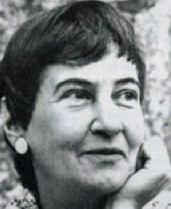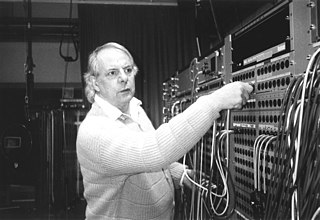Related Research Articles

On the Corner is a studio album by American jazz trumpeter, bandleader, and composer Miles Davis. It was recorded in June and July 1972 and released on October 11 of the same year by Columbia Records. The album continued Davis's exploration of jazz fusion, and explicitly drew on the influence of funk musicians Sly Stone and James Brown, the experimental music of Karlheinz Stockhausen, ideas by composer Paul Buckmaster, and the free jazz of Ornette Coleman.
Hans (Heinrich) Keller was an Austrian-born British musician and writer, who made significant contributions to musicology and music criticism, as well as being a commentator on such disparate fields as psychoanalysis and football. In the late 1950s, he invented the method of "wordless functional analysis", in which a musical composition is analysed in musical sound alone, without any words being heard or read. He worked full-time for the BBC between 1959 and 1979.

The Helikopter-Streichquartett is one of Karlheinz Stockhausen's best-known pieces, and one of the most complex to perform. It involves a string quartet, four helicopters with pilots, as well as audio and video equipment and technicians. It was first performed and recorded in 1995. Although performable as a self-sufficient piece, it also forms the third scene of the opera Mittwoch aus Licht.
In music, moment form is defined as "a mosaic of moments", and, in turn, a moment is defined as a "self-contained (quasi-)independent section, set off from other sections by discontinuities".

Aus den sieben Tagen is a collection of 15 text compositions by Karlheinz Stockhausen, composed in May 1968, in reaction to a personal crisis, and characterized as "Intuitive music"—music produced primarily from the intuition rather than the intellect of the performer(s). It is Work Number 26 in the composer's catalog of works.

Zyklus für einen Schlagzeuger is a composition by Karlheinz Stockhausen, assigned Number 9 in the composer's catalog of works. It was composed in 1959 at the request of Wolfgang Steinecke as a test piece for a percussion competition at the Darmstadt Summer Courses, where it was premièred on 25 August 1959 by Christoph Caskel. It quickly became the most frequently played solo percussion work, and "inspired a wave of writing for percussion".

Kontakte ("Contacts") is an electronic music work by Karlheinz Stockhausen, realized in 1958–60 at the Westdeutscher Rundfunk (WDR) electronic-music studio in Cologne with the assistance of Gottfried Michael Koenig. The score is Nr. 12 in the composer's catalogue of works, and is dedicated to Otto Tomek.

The Klavierstücke constitute a series of nineteen compositions by German composer Karlheinz Stockhausen.
York Höller is a German composer and professor of composition at the Hochschule für Musik Köln.
Indeterminacy is a composing approach in which some aspects of a musical work are left open to chance or to the interpreter's free choice. John Cage, a pioneer of indeterminacy, defined it as "the ability of a piece to be performed in substantially different ways".
A musical hoax is a piece of music composed by an individual who intentionally misattributes it to someone else.

Klang —Die 24 Stunden des Tages is a cycle of compositions by Karlheinz Stockhausen, on which he worked from 2004 until his death in 2007. It was intended to consist of 24 chamber-music compositions, each representing one hour of the day, with a different colour systematically assigned to every hour. The cycle was unfinished when the composer died, so that the last three "hours" are lacking. The 21 completed pieces include solos, duos, trios, a septet, and Stockhausen's last entirely electronic composition, Cosmic Pulses. The fourth composition is a theatre piece for a solo percussionist, and there are also two auxiliary compositions which are not part of the main cycle. The completed works bear the work (opus) numbers 81–101.

Susan Bradshaw was a British pianist, teacher, writer, and composer. She was mainly associated with contemporary music, and especially with the work of Pierre Boulez, several of whose writings she translated. As a critic and musicologist she contributed to a number of magazines and journals over several decades; the titles included Contact, Music and Musicians, Tempo and The Musical Times.

Freitag aus Licht, the main body of which is also titled Freitag-Versuchung, is the fifth to be composed of the seven operas that comprise Licht (Light), by Karlheinz Stockhausen. It was the last of the operas to receive a staged production with the composer's involvement.

Trans is a composition for orchestra and tape by the German composer Karlheinz Stockhausen, written in 1971. It is Number 35 in the composer's catalog of works.

Originale, musical theatre with Kontakte, is a music theatre work by the German composer Karlheinz Stockhausen, written in collaboration with the artist Mary Bauermeister. It was first performed in 1961 in Cologne, and is given the work number 12⅔ in Stockhausen's catalogue of works.

Donnerstag aus Licht is an opera by Karlheinz Stockhausen in a greeting, three acts, and a farewell, and was the first of seven to be composed for the opera cycle Licht: die sieben Tage der Woche. It was written between 1977 and 1980, with a libretto by the composer.

Refrain for three players is a chamber music composition by Karlheinz Stockhausen, and is number 11 in his catalog of works.
The Konkrete Etüde is the earliest work of electroacoustic tape music by Karlheinz Stockhausen, composed in 1952 and lasting just three-and-a-quarter minutes. The composer retrospectively gave it the number "1⁄5" in his catalogue of works.

Plus-Minus, 2 × 7 pages for realisation, is a composition for one or several performers by Karlheinz Stockhausen, first written in 1963 and redrafted in 1974. It is Nr. 14 in the composer's catalogue of works, and has a variable performing length that depends on the version worked out from the given materials. The score is dedicated to Mary Bauermeister.
References
This article needs additional citations for verification .(June 2009) |
- Anon. 1961. "B.B.C. Deny Hoax". The Times issue 55148 (1 August): 10, col. D.
- Garnham, Alison. 2003. Hans Keller and the BBC: The Musical Conscience of British Broadcasting, 1959–79. Aldershot, Hants; Burlington, VT: Ashgate Publishing, Ltd. ISBN 0754608972.
- Keller, Hans, Susan Bradshaw, and Alvar Lidell. 1961. "Piotr Zak: Mobile for Tape and Percussion. BBC Third Programme (5 June). Hans Keller Online (Retrieved 15 January 2015).
- Lewis, Anthony. 1961. "B.B.C. Admits a Musical Hoax: Noise by Imaginary Composer". New York Times (2 August): 1.
- Mitchell, Donald. 1961a. "Unbearable Simplicity in Newest Music: Naive Mr. Nono". Daily Telegraph and Morning Post, no. 33,010 (Tuesday 6 June): 16.
- Mitchell, Donald. 1961b. "Critics Were Not Deceived: Zak and His 'Mobile'", letter to the editor, Daily Telegraph and Morning Post (Friday 18 August): 10.
- Myers, Rollo H. 1961. "Critic on the Hearth: Music: Too Rarified?". The Listener and B.B.C. Television Review 65, no. 1681 (Thursday 15 June): 1064–65.
- Noble, Jeremy. 1961. "Disappointing Mobile". The Times, issue 55100 (6 June) p. 16, col. E.
- Ottaway, Hugh. 1967. "Prospect and Perspective". In The Symphony, edited by Robert Simpson, 2:[ page needed ]. Middlesex, England: Penguin Books Ltd. ISBN 0-14-020773-2.
- Porter, Andrew. 1961. "Editorial". Musical Times 102, no. 1424 (October): 618.
- Zak, Pjotr [alias Hans Keller]. 1962. "Zak on Stockhausen". The Musical Times 103, no. 1433 (July): 484–85.